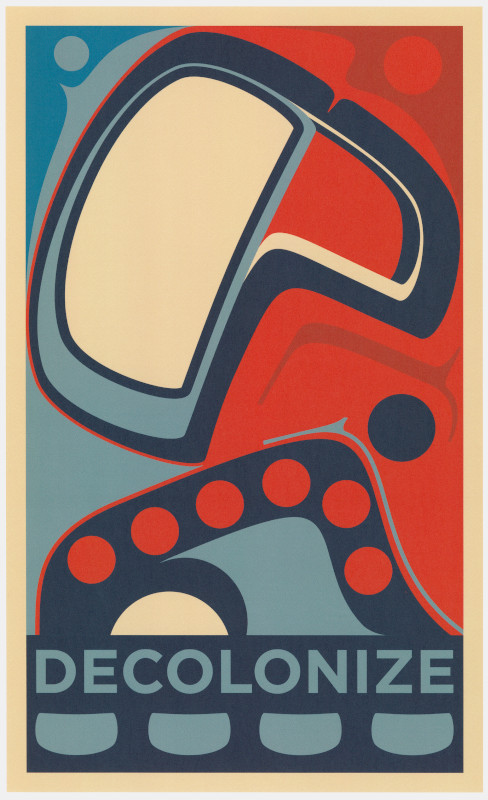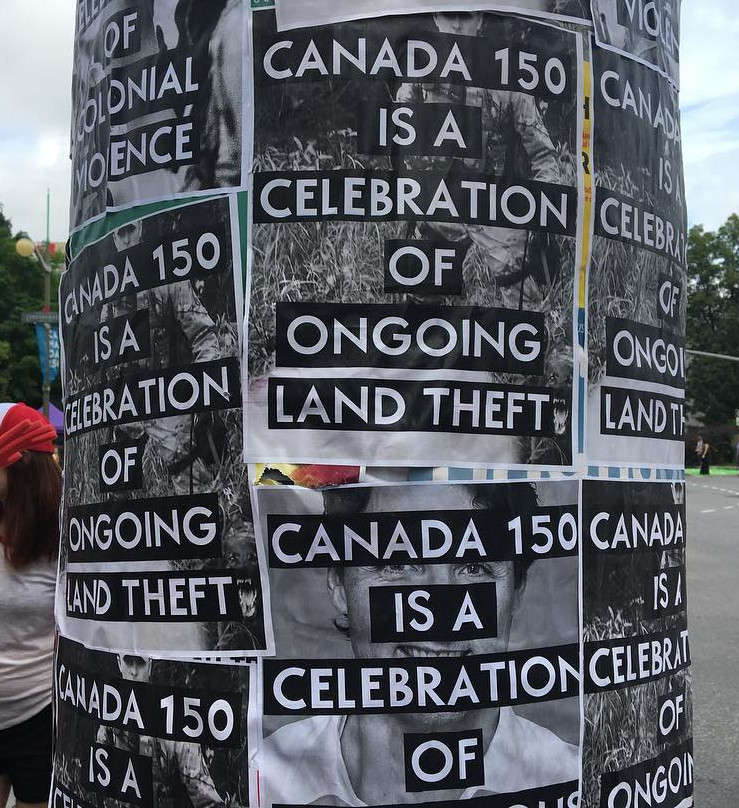Since the 2024 United States election, many Canadians have been enthusiastically expressing patriotism and celebrating Canada as a unified nation. Indigenous Peoples, however, are not comfortable with this nationalist outpouring. To understand this moment in 2025, we look back at Indigenous responses to the “Canada 150” celebrations.
In January 2017, Canada began the fanfare surrounding its 150th birthday. But many Indigenous nations and communities were instead mourning 150 years of colonial oppression and violence, including dispossession and cultural erasure.
Christi Belcourt, Maria Campbell, Tanya Kappo, and Isaac Murdoch were among the many Indigenous artists, activists, and Knowledge Keepers not celebrating Canada’s sesquicentennial. Instead, they created #Resistance150: a project and counter-movement intended to highlight harsh truths about Canada. They wanted to show the many ways Indigenous Peoples have resisted and continue to resist discriminatory and oppressive policies of the Canadian government.
#Resistance150 is an expression of a broader movement within Indigenous art in Canada. This movement works to provoke dialogue about Canada’s past and educate about Indigenous resurgence, survival and resilience.

Many forms of Indigenous art resist, reclaim and rework mainstream cultural references. In a series of prints titled There Is Hope, If We Rise, Sonny Assu references Shepard Fairey’s iconic Obama “Hope” poster. But Assu’s works employ Kwakwaka’wakw design motifs and decolonial texts to reflect on the Idle No More movement.
Canadian Museum of History, LH2016.30.1.12
Challenging national myths and misconceptions
#Resistance150, though not celebratory, is not about rejecting Canada outright. It’s about confronting colonial legacies. This includes the myth of Canada being a benevolent, multicultural nation built without cost or harm. Because Indigenous Peoples paid the cost and harm of the nation-building project.
The last 150 years have been marred by
- forced displacement or removal from traditional territories
- the violent imposition of the residential school system and its legacies
- ongoing systems of inequality that harm and disadvantage Indigenous Peoples in areas such as education, healthcare and justice
#Resistance150 was an act of survival and resistance that asserted Indigenous presence. It refused the Canadian tendency to dismiss colonial history as inconvenient to national pride. This countermovement called into question the unspoken colonialism of Canada’s 150th celebration. It advocated for a more inclusive future that recognizes all of Canada’s history.
Celebrating Indigenous survival and resurgence
Indigenous artists across Canada used the #Resistance150 hashtag on various social media platforms to problematize the upcoming celebrations of Canada’s birthday.
Nadya Kwandibens, an Anishnaabe photographer, was quick to respond to the growing media and social media frenzy around Canada 150. In January 2017, Kwandibens tweeted on X (formerly Twitter): “Don’t tag my art #Canada150 and/or #reconciliation. My art does not celebrate colonialism nor does it bow to the industry of reconciliation.” Her comment was shared hundreds of times.
Inspired by #Resistance150, Kwandibens made it clear that her photos are not portraits of happy and reconciled Indigenous Peoples. Rather, they depict Indigeneity in contemporary urban settings to challenge the erasure of Indigenous cultures.

Tasha Spillet, photographed in Winnipeg, Manitoba, June 2016 for the Concrete Indians series by Nadya Kwandibens.
The photographs in her Concrete Indians series rewrite stereotyped depictions of Indigenous Peoples in loincloths against picturesque backgrounds. Kwandibens pictures Indigenous folks living in the concrete jungle while expressing their cultural heritage. She shows that resistance has always meant adaptation for Indigenous Peoples across Canada.
Her portrait of Tasha Spillet gained wide circulation on social media during 2017. Tasha shows resistance and adaptability through this portrait. She is dressed in contemporary fashion, accessorized by a kokum scarf often seen on the Pow Wow trail. She is holding an Apple laptop decorated with a “Decolonize” sticker, and carries a feathered fan adorned with beadwork of a jingle dress dancer.
She is the epitome of a contemporary Indigenous woman. She has adapted to the world around her whilst staying true to her cultural heritage. This can be seen not only in how she dresses but in what she chooses to carry with her. This portrait shows that despite colonial and governmental policies that tried to erase Indigenous Peoples and their cultures, they have adapted, they have resisted, and they are still resisting. It’s the 21st century and Indigenous Peoples continue to adapt. They live in cities and pursue colonial education, all the while expressing and maintaining their cultural roots.
#Resistance150 was a call to action for all non-Indigenous people in Canada. It was a call to reflect on the buried truths that built this country. It was a call to recognize the continued work by Indigenous Peoples to resist cultural erasure and adapt to contemporary Canadian life.
Uncomfortable national truths
Canada’s 150th birthday was an opportunity for everyone in Canadato reflect on our collective history, however distressing it is at times. #Resistance150 was a call to action for everyone in Canada to be uncomfortable with our difficult shared history. It invites us to resist the easily digestible myths of our past. Indigenous artists and Knowledge Keepers led and will continue to lead resistance movements. They bring out the spirits of our shared history, which is more important than ever.

Across Canada, anticolonial street art offered critical responses to celebratory Canada 150 patriotism.
Flickr/ bella_velo
Several years later, Canada grapples with the discovery of unmarked graves at residential school sites, ongoing systemic racism, and looming economic threats. We watch the United States erode its own history, denying and ignoring anything that disturbs the “Make America Great Again” narrative. The lessons of #Resistance150 feel even more urgent. Its main messages still hold true: Celebration cannot be built on denial and must never come at the expense of truth.
When we think of Canadian nationalism, it is important to consider whose story we are telling. Ask yourself: Does Canada really have a single, unified national story? Or is it the diversity of perspectives that makes us a strong nation?

Kristine McCorkell
Kristine McCorkell (Kanien'kehá:ka from Six Nations of the Grand River) joined the research team in 2022. They are responsible for the Indigenous Arts collection, including acquisitions, research and relationship building in this area.
Read full bio of Kristine McCorkell